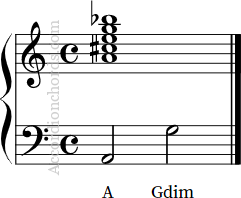AKA: G7(b5), G7/b5, G7(-5), G7 Flat 5, G Dominant 7th b5, G Dominant Seventh Flat Fifth
G7b5 Chord Chart for Piano Accordion

7b5 Chords
A dominant 7b5 chord is a chord that consists of a root, a major 3rd, a diminished 5th, and a minor 7th. It can be built by stacking a major 3rd interval, followed by a diminished 3rd interval, and finally a major 3rd interval on top of the root note. This creates a distinctive, dissonant sound that is often used to add tension and dissonance to a musical composition. This chord is commonly used in jazz and blues music.
Equivalent chords:
A 7b5 chord is equivalent to a chord of the same kind built 3 steps up or 3 steps down.
For example, C7b5 is equivalent to F#7b5 (F# is three steps above C) just as it is equivalent to Gb7b5 (Gb is three steps below C).
The interval between the root and the flattened 5th (diminished fifth or augmented fourth) is called a Tritone which divides the octave in half, so going up three tones or going down three tones is the same thing.
For example:
(Please note that chord inversions do not work on the Stradella bass system as they do on other instruments or on the accordion keyboard itself. So although these equivalent chords have the exact same notes, they are not interchangeable and should not be intended as inversions of the same chord, at least for what concerns the left hand.)
G7b5: In-depth analysis
For a more in-depth grasp of the G7b5 chord, delve into my article titled “G7b5 Piano Chord – Charts, Harmony, and Music Theory” on ChordsAround.com
7b5 Chords on Accordion
On a standard bass accordion, you can play 7b5 chords by combining a root note and the dominant 7th chord built on its tritone (augmented 4th or diminished 5th interval).
For example, in the key of D, the tritone can be found by subtracting a half step from the perfect fifth interval, which is A. This means that the tritone of D is Ab. If we combine a D root note with an Ab7 chord (Ab, C, *no 5th, Gb), we get a D7b5 chord (D, F#, Ab, C).
The Stradella bass system layout on a standard bass accordion allows you to play this chord in two ways: by playing the root note on the roots column or on the counter bass column. While the counter bass pattern may seem easier to play, it’s not always the case because the counter bass can be distant from the chords that are usually played in a particular key.
*(Dominant 7th chords buttons on standard bass accordion don’t play the 5th)

Notes:
G, B, D♭, F
Intervals:
R, 3°, dim5°, m7°
Left hand:
G + D♭7
(Fx + C#7)
Fingering:
2 + 5 (bass pattern)
or
3 or 4 + 2 (counter bass pattern)